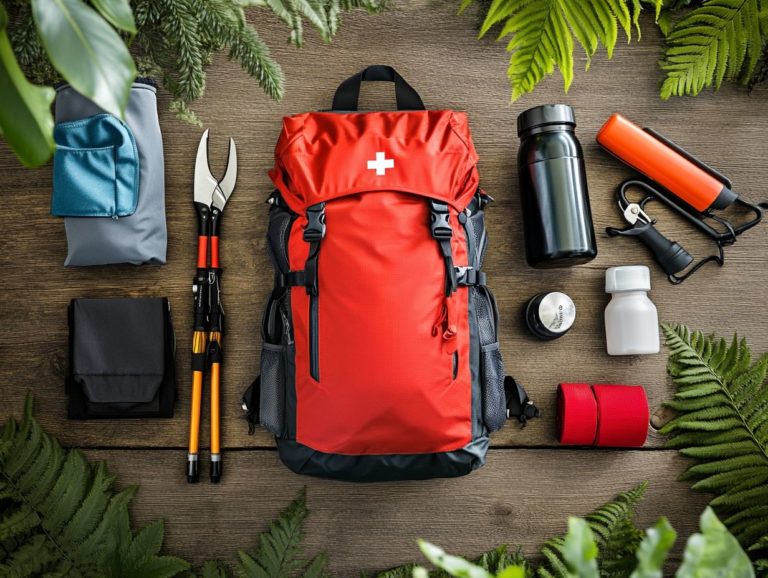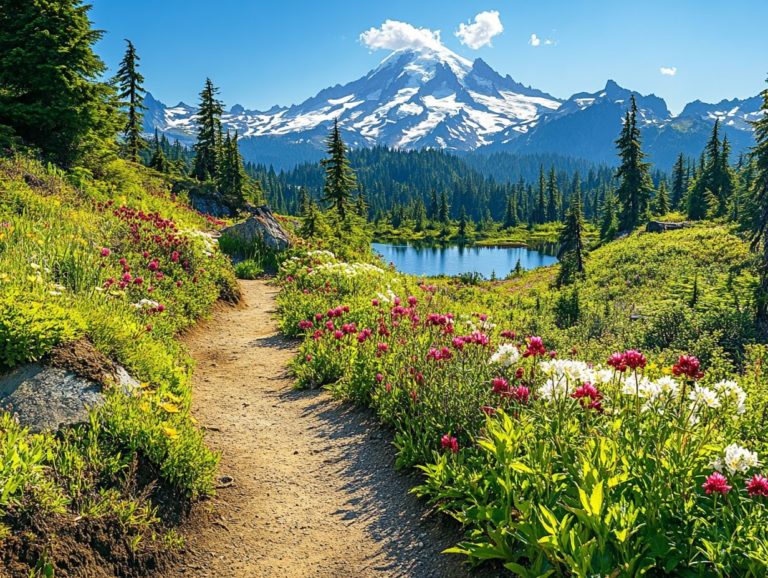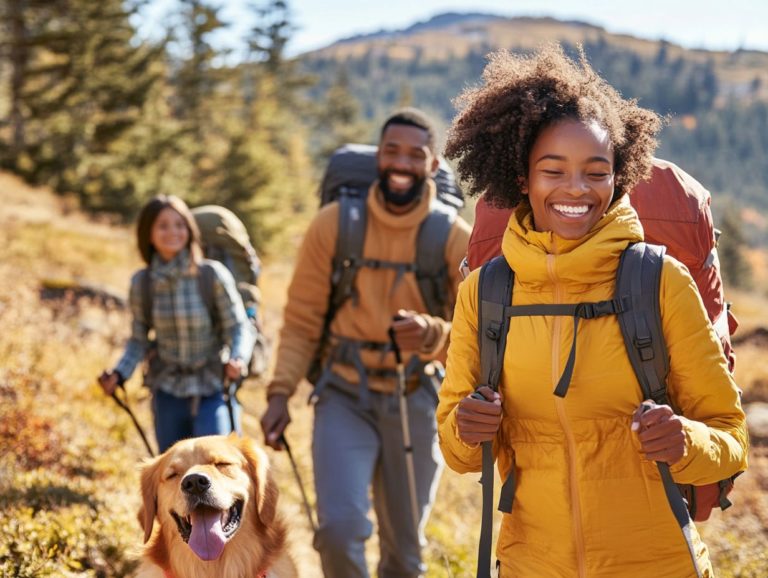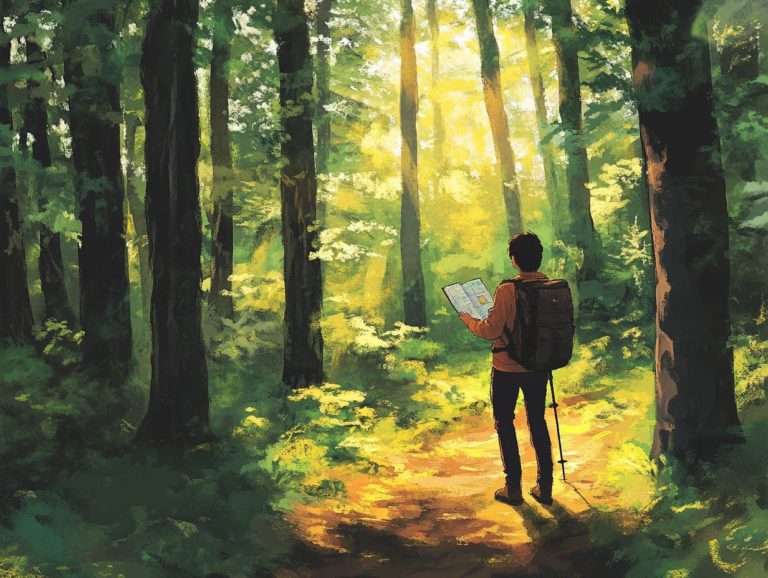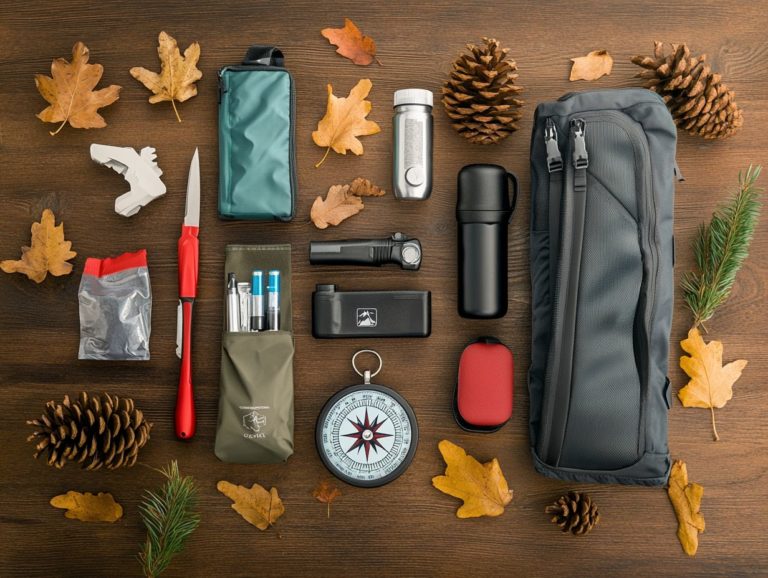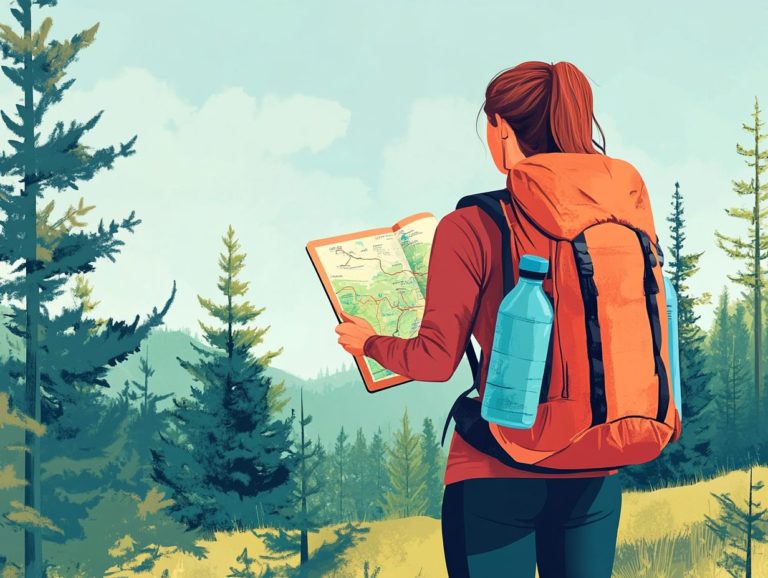Best Hiking Gear for Hot Weather
Ready to conquer the trails even in the blazing sun? Let s gear up for your next summer hike!
Hiking in hot weather can be an exhilarating yet challenging experience. It demands the right gear to ensure your comfort and safety.
Opting for lightweight, breathable clothing and essential sun protection is crucial. The right equipment can transform your outdoor adventure from enjoyable to extraordinary.
This guide will delve into must-have items such as durable hiking shoes and hydration packs. It will also provide tips on selecting the best gear for soaring temperatures.
By staying prepared, you can fully embrace and enjoy every moment of your hike.
Contents
- Key Takeaways:
- 1. Lightweight and Breathable Clothing Options
- 2. Sun Protection Essentials
- 3. Hydration Pack or Water Bottle
- 4. Durable and Comfortable Hiking Shoes
- 5. Sun Hat or Visor
- 6. Hiking Socks with Moisture-Wicking Properties
- 7. Insect Repellent
- 8. Trekking Poles for Stability and Support
- 9. Lightweight and Quick-Drying Towel
- 10. First Aid Kit
- 11. Portable and Collapsible Chair
- 12. Lightweight and Compact Sleeping Bag
- 13. Navigation Tools
- 14. Emergency Shelter
- 15. Portable and Rechargeable Fan
- What Are the Benefits of Having the Right Hiking Gear for Hot Weather?
- Frequently Asked Questions
- What are the essential clothing items for hot weather hiking?
- What type of footwear is recommended for hot weather hiking?
- What should I look for in a backpack for hot weather hiking?
- How can I stay hydrated while hiking in hot weather?
- Are there any accessories that can help me stay cool during hot weather hikes?
- Is there any specific gear I should have for protecting myself from the sun?
Key Takeaways:
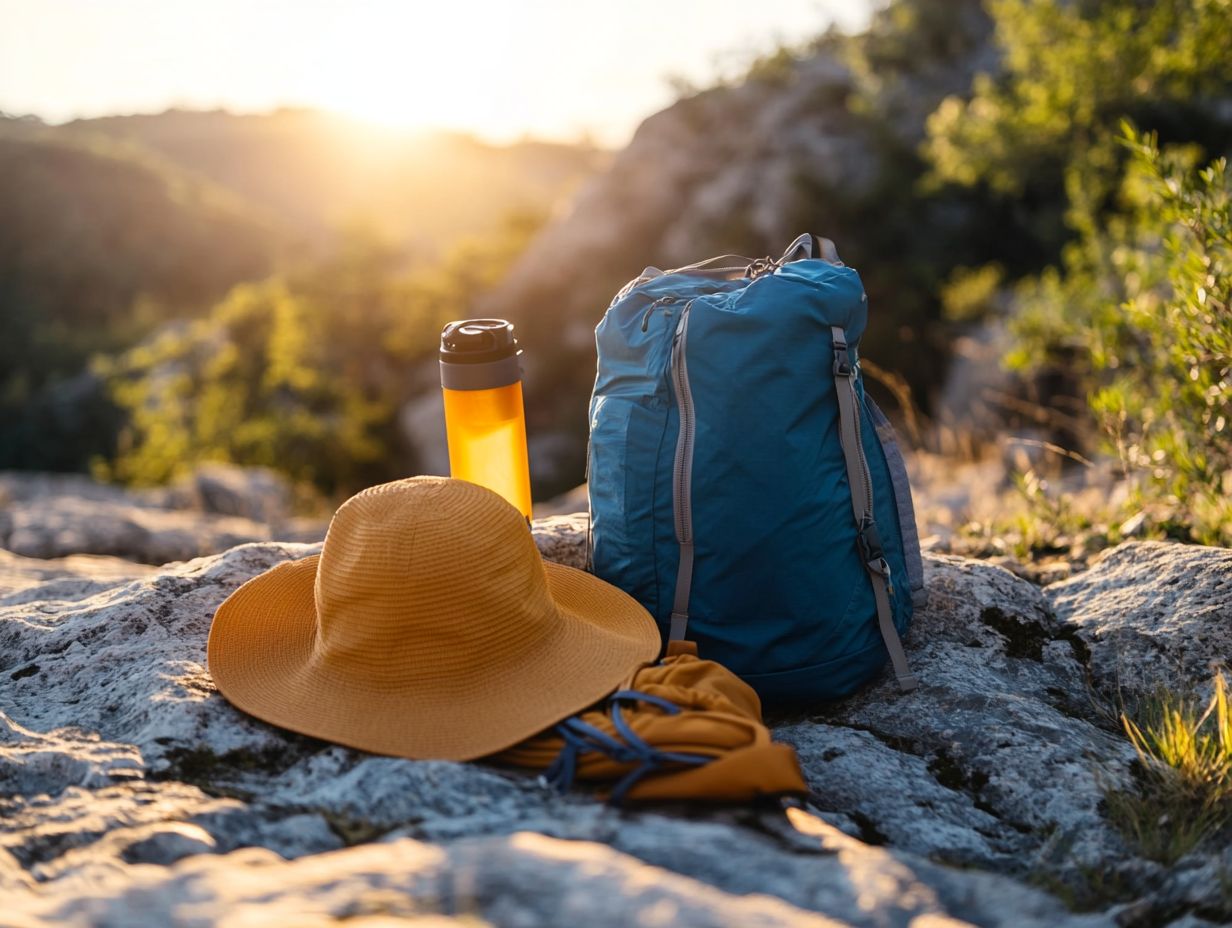
- Invest in lightweight, breathable clothing to stay cool and comfortable on hot weather hikes.
- Protect yourself from the sun with essentials like sunscreen, sunglasses, and a hat.
- Stay hydrated with a hydration pack or water bottle to prevent heat exhaustion and dehydration.
1. Lightweight and Breathable Clothing Options
When it comes to summer hiking, selecting lightweight and breathable clothing options is essential for ensuring both comfort and performance. Opt for high-quality hiking attire made from synthetic materials like moisture-wicking fabrics that dry quickly and regulate your temperature perfect for those hot days.
Brands like Patagonia and Arc’teryx offer a wide range of hiking pants, shirts, and shorts designed with lightweight layers that prioritize breathability and mobility. Choosing the right clothing not only enhances your hiking experience but also helps prevent overheating.
Consider hiking pants made from stretchy, lightweight materials that often feature zip-off legs. This allows you to convert them into shorts as conditions change. Quick-drying base layers are also critical, as they wick moisture away from your skin, keeping you dry and comfortable.
For example, Patagonia’s Capilene series offers great breathability and odor resistance. Meanwhile, Arcteryx s Gamma LT shorts combine flexibility with durability.
By investing in these thoughtfully designed pieces, you can maintain an optimal body temperature. This will boost your overall performance and elevate your hiking experience, whether navigating rugged trails or enjoying a leisurely stroll through picturesque scenery.
2. Sun Protection Essentials
Sun protection is crucial for your summer hiking adventures, especially in regions where the sun can be relentless. To fend off harmful UV rays, you need a combination of sunscreen, lightweight layers, and a stylish sun hat or visor. This trifecta will significantly reduce the risk of sunburn.
When choosing sunscreen, aim for one with an SPF of at least 30 for broad-spectrum protection against both UVA and UVB rays. Remember to reapply every two hours or more often if you’re sweating or swimming.
Hats with wide brims provide maximum coverage. Opt for breathable fabrics to stay comfortable during warm hikes. Lightweight, long-sleeved clothing is also a wise choice, as it protects your skin and helps regulate body temperature.
If you’re trekking through particularly exposed areas, consider adding UV-blocking sunglasses and neck gaiters to your gear. These additional protective items will further shield you from the sun’s harmful effects, allowing you to hike with confidence and peace of mind.
Don’t wait until you’re on the trail to realize you need sun protection. Equip yourself now for the thrill of adventure!
3. Hydration Pack or Water Bottle
Staying hydrated is essential during your summer hikes. Choosing between a hydration pack and a water bottle is a crucial part of your gear selection.
A hydration pack offers the convenience of hands-free access to water. In contrast, a sturdy water bottle, such as those from Nalgene, provides versatility and easy refills along the trail.
Both options have their merits. Your decision should hinge on the length of your hike and your personal preferences. Adequate hydration fuels your energy and elevates your entire hiking experience.
When choosing between these options, keep in mind the duration of your hike and the weather conditions.
For shorter, cooler excursions, a compact water bottle may be just fine. However, for longer treks in the summer heat, a hydration pack becomes more practical, allowing you to carry a larger supply of water without frequently stopping for a sip.
Aim for about half a liter of water per hour, adjusting for temperature and exertion. Stay vigilant for signs of dehydration, like fatigue or dizziness. Remember to sip water regularly instead of waiting until you’re parched.
During the summer months, adding electrolyte tablets can be a smart move, helping to replace essential minerals lost through sweat while keeping your energy levels and stamina intact.
4. Durable and Comfortable Hiking Shoes
Choosing the right hiking shoes can be a game-changer for your comfort and safety on the trail! You want durable shoes made from high-quality materials that deliver the support and grip necessary for tackling various terrains.
Brands like Patagonia and Eddie Bauer offer a selection that balances comfort and durability, allowing you to conquer challenging trails without compromising on performance.
Finding that perfect fit is essential for maximizing your hiking experience while keeping your feet blissfully comfortable. A well-fitted shoe elevates your comfort and reduces the likelihood of blisters and soreness during extended treks.
Opt for premium materials like Gore-Tex, which keeps your feet dry yet breathable, or breathable mesh. These materials provide both waterproofing and ventilation ideal for whatever Mother Nature throws your way.
When exploring options, consider the range of hiking shoes available, from lightweight trail runners for quick excursions to robust boots designed for rugged terrains. Each type boasts specific features, such as reinforced toe caps and cushioned midsoles, perfect for absorbing shock and providing exceptional traction.
As you weigh your choices, consider the versatility offered by trusted brands like Patagonia and Eddie Bauer, both renowned for their unwavering commitment to durability and comfort.
5. Sun Hat or Visor
A sun hat or visor is a critical piece of your summer hiking gear. It offers essential sun protection while keeping you cool on the trail.
These lightweight accessories shield your face and neck from harmful UV rays, making them a must-have for long hikes in open areas.
Beyond just UV protection, they play a crucial role in regulating your body temperature, helping you avoid overheating during strenuous stretches.
When selecting the perfect sun hat or visor, consider features like adjustable straps and breathable mesh panels to enhance fit and airflow.
Whether you lean towards a wide-brimmed hat for maximum coverage or a sporty visor for a sleek, minimalistic look, these accessories effortlessly combine functionality with style, perfectly complementing your hiking ensemble.
By investing in a quality sun hat or visor, you re not only safeguarding yourself; you re also enhancing your overall hiking experience.
6. Hiking Socks with Moisture-Wicking Properties
Hiking socks with moisture-wicking properties are crucial for your hiking gear, especially during summer. They help keep your feet dry, regulate temperature, and prevent blisters for more comfort on the trail.
Choose socks made from synthetic materials that offer cushioning and durability. Consider compression socks for added support and reduced fatigue on longer hikes.
Select the right hiking socks based on your needs. For short, warm hikes, go for lightweight socks. Heavier, cushioned designs are best for rugged terrain and cold conditions.
Don’t overlook specialized options like merino wool socks. They provide natural moisture-wicking (the ability to draw sweat away from your skin) and temperature regulation, making them perfect for any season.
Pay close attention to these details for an unbeatable hiking experience. Equip yourself with socks that support your adventures and keep your feet blissfully blister-free!
7. Insect Repellent
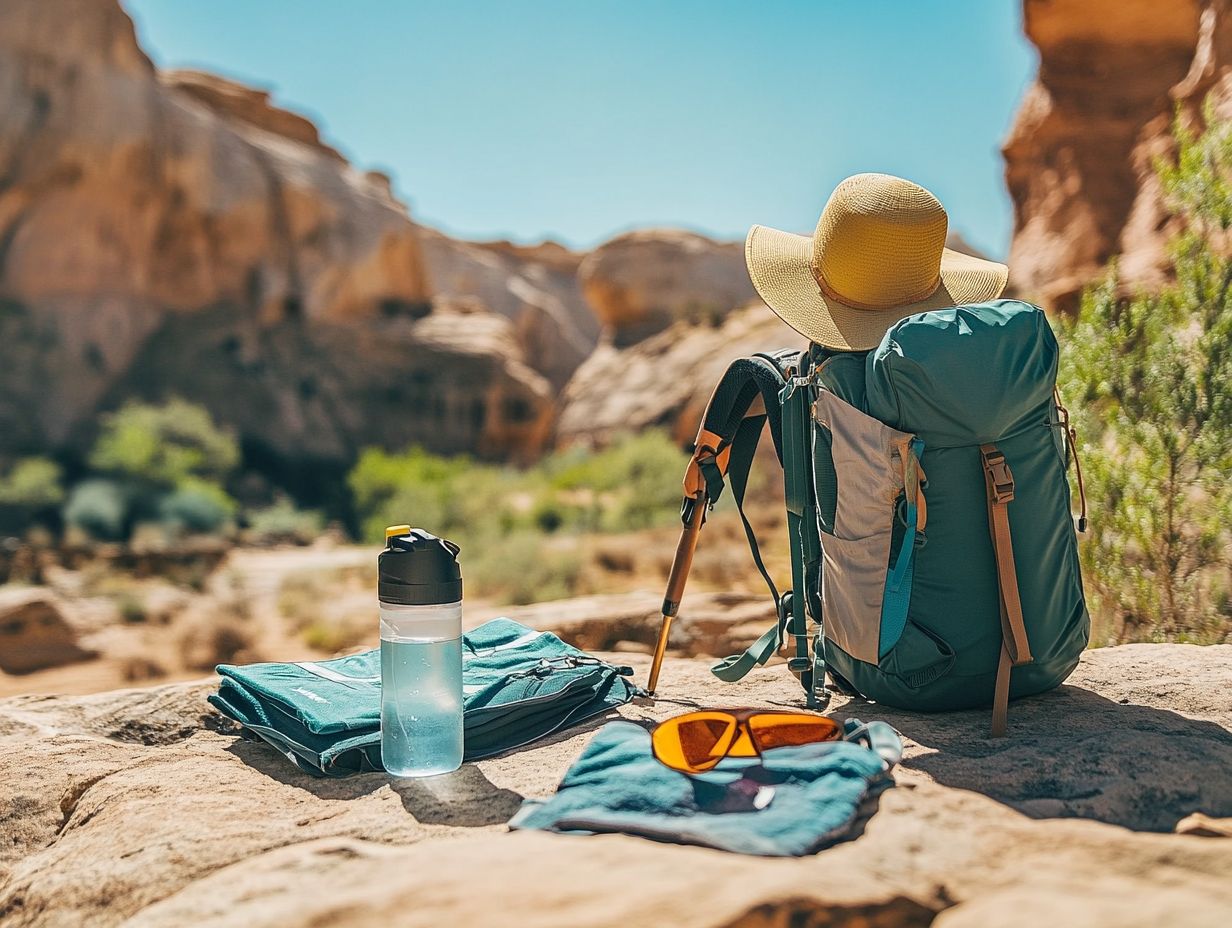
Using insect repellent is critical for a comfortable and safe summer hiking experience. It shields you from bothersome and potentially harmful bugs. Whether you choose a repellent with DEET or opt for natural alternatives, you’ll effectively fend off mosquitoes and ticks.
Apply repellent to your exposed skin and clothing for essential protection. This allows you to immerse yourself in the splendor of the outdoors without the distraction of pesky bites.
Finding the right repellent is paramount. Various formulations target different insects. Products containing Picaridin repel both mosquitoes and ticks while offering a lighter feel than DEET. For a natural approach, consider repellents infused with oil of lemon eucalyptus or citronella.
For maximum effectiveness, cover all exposed skin evenly. Pay special attention to snug areas, like the waist and cuffs. Remember to reapply according to instructions, especially after sweating or swimming, to maintain top-notch protection throughout your hike.
8. Trekking Poles for Stability and Support
Trekking poles are invaluable for your summer hikes. They provide the stability and support you need on uneven terrains while easing the strain on your joints. These lightweight companions enhance balance and enable efficient movement during steep climbs and descents.
To use trekking poles effectively, master a few techniques. Adjust the length to suit your height and maintain a comfortable grip. When descending, lean slightly forward while extending your poles for better balance. When ascending, push the poles against the ground to alleviate some load on your legs.
Caring for your poles is crucial. Regularly check for any wear and ensure the tips are kept sharp to enhance performance and longevity. By thoughtfully integrating trekking poles into your hiking routine, you can embark on safer, more enjoyable outdoor adventures.
9. Lightweight and Quick-Drying Towel
A lightweight and quick-drying towel is essential for summer hiking. It elevates your experience by allowing you to wipe sweat, clean hands, or dry off after a dip.
These towels are versatile. They can serve as a picnic blanket or cushion for breaks.
Made from materials like soft cloth or light fabric, these towels offer great absorbency and dry quickly. This ensures they are easy to pack in your backpack.
When packing, fold and roll the towel tightly to save space and stay organized. A quick-drying towel is invaluable in humid conditions or near water sources, where splashes or rain can surprise you.
With a bit of planning, this simple accessory can become a reliable ally, enhancing your comfort and enjoyment on every hike.
10. First Aid Kit
A well-stocked first aid kit is essential for any summer hiking adventure. It ensures you’re prepared for injuries or emergencies on the trail.
As you customize your kit, think about the specific risks tied to the terrain you’ll encounter, like rocky paths, dense forests, or high-altitude trails. Include blister prevention patches for long treks and insect bite relief for wooded areas.
If you plan to swim or cross creeks, adding waterproof bandages is beneficial. Personalizing your first aid kit tackles unique challenges and boosts your peace of mind.
For those venturing into rock climbing or mountain biking, including specialized items like splints or a snake bite kit is invaluable. Being ready for anything can make all the difference in your outdoor experience.
11. Portable and Collapsible Chair
Investing in a portable and collapsible chair can elevate your comfort during summer hiking trips. It provides a convenient spot to rest and soak in the scenery.
These lightweight chairs are easy to transport. They re ideal for hikers who appreciate comfort without the extra weight.
Whether you re taking a breather during a long trek or relaxing at your campsite, a collapsible chair lets you unwind effortlessly. Incorporating one into your gear collection enhances your adventures.
When choosing a collapsible chair, look for lightweight models under three pounds. Ease of setup is crucial; designs that require minimal effort can change the game during a hike.
Durability is also important. A sturdy chair can handle rough terrain while providing the support you need.
Imagine reaching a breathtaking overlook after a tough trek. With a portable chair, you can kick back and revel in the stunning views.
With a reliable chair in tow, breaks become genuine moments of rejuvenation, making every outing enjoyable.
12. Lightweight and Compact Sleeping Bag
A lightweight and compact sleeping bag is essential for your summer hiking and camping adventures. It provides a cozy spot to unwind after a day of exploration.
These bags are typically made from durable materials like ripstop nylon or polyester. They strike the perfect balance between longevity and minimal weight.
With temperature ratings designed for warmer conditions, they keep you comfortable while preventing overheating. This ensures you enjoy a restful night s sleep.
Utilizing a compression stuff sack is a game changer for packing. It condenses the bag for easier storage in your gear.
By prioritizing features like breathability and moisture-wicking properties, you can rest easy knowing comfort and convenience accompany you, no matter how far your adventures take you.
Having reliable navigation tools is crucial for your summer hiking adventures. They allow you to explore with both confidence and safety. Whether you prefer traditional maps or the convenience of modern GPS devices, being equipped with the right tools enables you to track your route and avoid getting lost in unfamiliar terrain.
Investing in a high-quality compass and mastering its use alongside your maps can significantly boost your navigational confidence. Proper navigation tools not only enhance your hiking experience but also ensure your safety as you embrace the great outdoors.
Understanding the strengths and weaknesses of each navigation option is essential. Maps offer a comprehensive overview and are consistently reliable. However, they require you to skillfully interpret landforms and scales. Compasses are invaluable for orienting maps and using landmarks for direction, though they may take some practice to wield effectively.
However, GPS devices deliver real-time location data and effortlessly track your routes, but they do depend on having enough power and signal. By combining these tools and refining your navigational skills, you can significantly reduce the risks associated with getting lost. This allows you to immerse yourself in nature’s beauty without a hint of fear.
14. Emergency Shelter
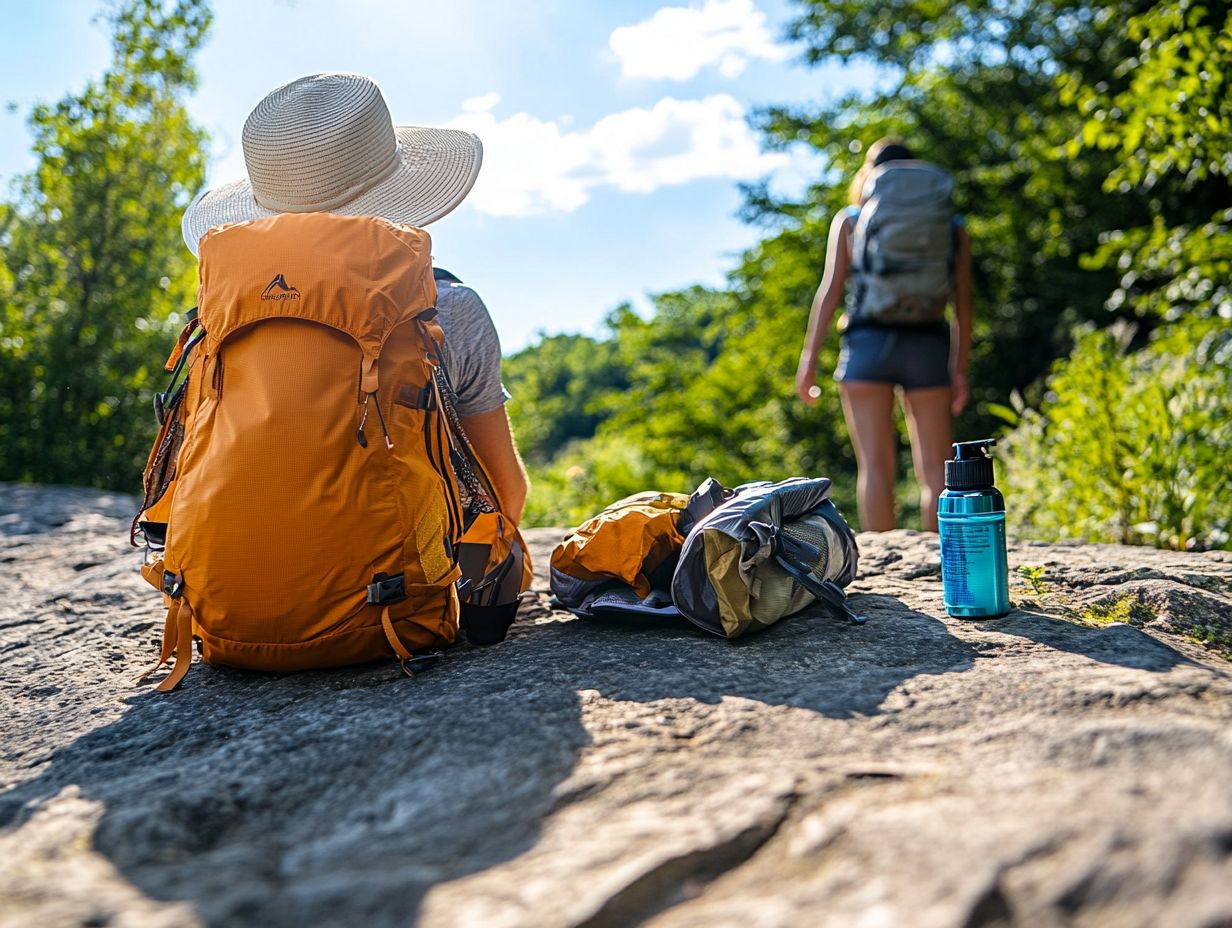
An emergency shelter is a must-have item for your summer hiking adventures. It serves as a reliable refuge when the unexpected strikes. Lightweight and compact, these shelters fit easily into your backpack, ensuring you re ready for sudden weather shifts or emergencies.
You have several options, such as emergency bivvy bags or lightweight tarps, each designed to shield you from the elements. Being equipped with an emergency shelter significantly boosts your safety and provides peace of mind while you explore remote trails.
Choosing the right type of shelter depends on the terrain and weather conditions you anticipate. For example, if you re venturing into areas susceptible to sudden thunderstorms or fierce winds, a sturdy, wind-resistant tarp may be your best bet. If you re navigating rugged landscapes, a versatile bivvy bag could offer essential insulation and protection.
By evaluating the forecast and assessing the local environment, you can make informed decisions about the most suitable emergency shelters. This proactive approach helps mitigate risks and ensures a safer, more enjoyable experience on the trail. Don t head out without it!
15. Portable and Rechargeable Fan
A portable and rechargeable fan can truly transform your comfort during summer hiking trips. It provides that much-needed refreshing breeze when the heat and humidity ramp up. Lightweight and easy to pack, these fans deliver immediate relief from the sweltering conditions, making your breaks much more enjoyable while helping to prevent overheating.
These fans also come in various designs, from sleek handheld models to larger clip-on versions. Many boast impressive battery life, allowing them to run for several hours on a single charge. Some even offer multiple speed settings, letting you customize the airflow to your desired comfort level. Pairing them with the right hiking outfit can further enhance your comfort on the trail.
To maximize their effectiveness, consider these practical tips:
- Position them strategically to catch those cooling breezes.
- Use them during your rest breaks.
- Make sure they are fully charged before heading out on a long hike.
With the right fan in your pack, along with the best hiking gear for kids, you can worry less about the heat and immerse yourself in the stunning beauty of nature surrounding you, whether you are exploring the Appalachian Mountains or hiking in Costa Rica. Prepare now and enjoy your summer hikes without worry!
What Are the Benefits of Having the Right Hiking Gear for Hot Weather?
Having the right hiking gear for hot weather is essential for ensuring your comfort and safety during summer hiking adventures. A well-chosen combination of lightweight clothing, hiking shorts, and essential accessories can elevate your hiking experience.
These items allow you to stay cool and dry. Lightweight, moisture-wicking shirts and pants regulate your body temperature and prevent chafing. This makes long treks much more enjoyable.
Breathable hiking shoes offer support and ventilation, significantly reducing the risk of blisters and discomfort. Accessories like wide-brimmed hats and UV-blocking sunglasses shield you from harmful sun exposure.
Hydration packs provide easy access to water, keeping you well-hydrated throughout your journey. These carefully selected pieces of gear work in harmony to enhance your comfort and safety.
They also allow you to fully enjoy the beauty of nature while using trusted brands like Patagonia or Arcteryx.
How Can One Choose the Right Hiking Gear for Hot Weather?
Choosing the right hiking gear for hot weather is about understanding the essentials. These will keep you comfortable and safe on the trail.
Prioritize lightweight, moisture-wicking materials for breathability and quick-drying capabilities, especially for clothing and accessories like shorts and hiking socks.
Assess factors such as terrain, the duration of your hike, and your comfort preferences to guide your selections. By taking this time, you can set yourself up for an enjoyable outdoor adventure.
Fit is crucial; your gear should allow for freedom of movement without being so loose that it leads to chafing. Choose gear that serves multiple purposes, offering sun protection, internal pockets for essentials, and easy adjustability.
Staying hydrated and shielded from the sun should be top priorities. Invest in a quality hydration pack and a broad-brimmed hat to elevate your experience. Each choice should reflect your unique needs.
What Are the Common Mistakes People Make When Choosing Hiking Gear for Hot Weather?
Many hikers stumble into common pitfalls when selecting hiking clothes for hot weather. These can significantly affect both comfort and safety on the trail.
Don’t overlook the critical role of breathable fabrics; they enhance airflow and help prevent overheating and excessive sweating. Also, avoid choosing an ill-fitting backpack that lacks proper ventilation features.
Many people underestimate how important it is to stay hydrated. Lightweight, portable water bottles, like those from GoMacro, are vital for sustaining your energy levels.
To elevate your trekking experience, consider investing in gear that prioritizes comfort and mobility. Opt for:
- Lightweight, moisture-wicking clothing
- Well-ventilated shoes
- A reliable sunhat
These choices can profoundly enhance your well-being and enjoyment as you navigate the great outdoors during the warmer months.
How Can One Stay Safe While Hiking in Hot Weather?
Staying safe while hiking in hot weather requires meticulous planning and awareness of potential risks like dehydration and heat-related illnesses. Adequate hydration is essential; drink water regularly and carry enough fluids for the hike.
Wear appropriate clothing and embrace sun protection measures like sunscreen and hats to fend off heat exhaustion and sunburn. Follow these safety tips to maximize your fun during summer hikes!
Keep an eye on trail conditions, as some paths can become more difficult in heat and dry weather. Stay vigilant for signs of changing weather; storms can appear suddenly and create hazards.
Choosing trails that offer shade can provide a welcome respite from the sun. Take regular breaks in cooler areas to help regulate your body temperature.
Lastly, always inform someone of your route and expected return time. This simple step adds an essential layer of safety to your adventure.
What Are Some Additional Tips for Hiking in Hot Weather?
When you’re hiking in hot weather, a few additional tips can greatly enhance your comfort and experience during the journey, especially if you take the time to choose quality brands like Eddie Bauer or Fjallraven.
Enhance your hike by wearing a wide-brimmed hat to shield your face from the sun. Make sure to apply sunscreen with high sun protection factor to protect any exposed skin. Opting for light-colored fabrics is also crucial; they reflect sunlight and help maintain a cooler body temperature. For more tips on essential gear, check out hiking gear: must-have items for all seasons.
Hydration strategies matter carrying a hydration pack allows you to sip water consistently instead of gulping it down infrequently. This frequent hydration not only replenishes lost fluids but also keeps your energy levels up, paving the way for a more enjoyable trek.
By being mindful of these factors, you can truly savor the beauty of nature without succumbing to the fatigue that heat can bring.
Frequently Asked Questions
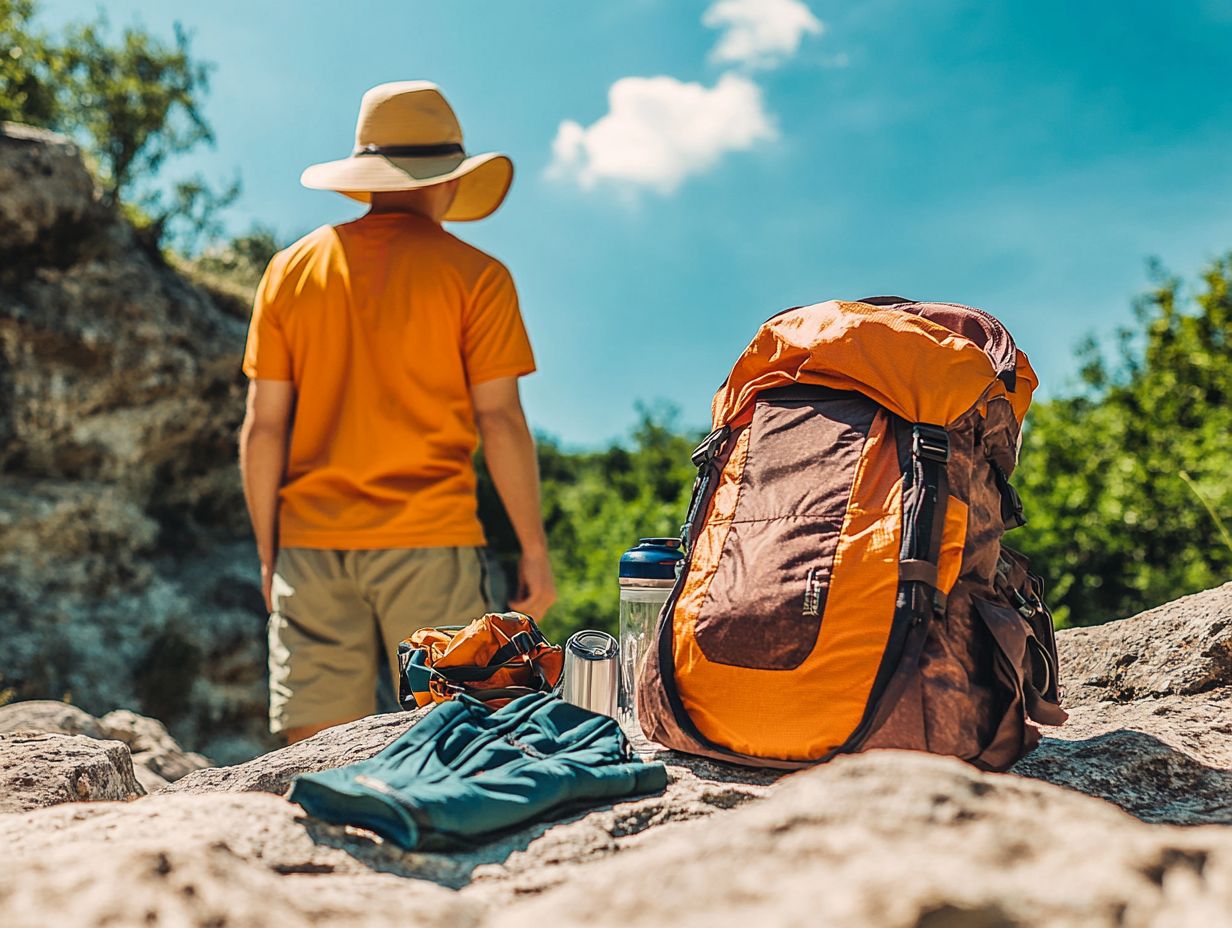
What are the essential clothing items for hot weather hiking?
The best hiking gear for hot weather includes lightweight and breathable clothing such as moisture-wicking shirts, quick-drying pants, and a wide-brimmed hat for sun protection.
What type of footwear is recommended for hot weather hiking?
Hiking sandals or lightweight hiking shoes with good ventilation are ideal for hot weather hiking. They offer comfort, breathability, and protection for your feet.
What should I look for in a backpack for hot weather hiking?
A backpack with a good suspension system, plenty of ventilation, and a hydration bladder is ideal for hot weather hiking. Look for one made with lightweight and breathable materials.
How can I stay hydrated while hiking in hot weather?
It’s important to bring plenty of water and electrolyte-replacing drinks on your hike. You can also consider a hydration bladder or water bottle with a built-in filter for refilling along the way.
Are there any accessories that can help me stay cool during hot weather hikes?
Yes, there are several accessories that can help keep you cool while hiking in hot weather. These include a cooling towel, a portable fan, and a sun umbrella.
Is there any specific gear I should have for protecting myself from the sun?
In addition to a wide-brimmed hat, it’s important to bring sunscreen, sunglasses, and lightweight clothing with UPF protection. You may also want to consider a sun shelter or sun sleeves for added protection.

